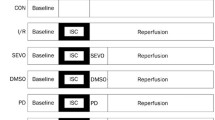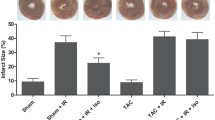Abstract
Sevoflurane postconditioning has been proven to protect the hearts against ischemia/reperfusion injury, manifested mainly by improved cardiac function, reduced myocardial specific biomarker release, and decreased infarct size. This study is to observe the effects of sevoflurane postconditioning on reperfusion-induced ventricular arrhythmias and reactive oxygen species generation in Langendorff perfused rat hearts. Compared with the unprotected hearts subjected to 25 min of global ischemia followed by 30 min of reperfusion, exposure of 3% sevoflurane during the first 15 min of reperfusion significantly improved cardiac function, reduced cardiac troponin I release, decreased infarct size and attenuated reperfusion-induced ventricular arrhythmia. Further analysis on arrhythmia during the 30 min of reperfusion showed that, sevoflurane postconditioning decreased both the duration and incidence of ventricular tachycardia and ventricular fibrillation. In the meantime, intracellular malondialdehyde and reactive oxygen species levels were also reduced. These above results demonstrate that sevoflurane postconditioning protects the hearts against ischemia/reperfusion injury and attenuates reperfusion-induced arrhythmia, which may be associated with the regulation of lipid peroxidation and reactive oxygen species generation.






Similar content being viewed by others
References
Jennings RB, Sommers HM, Smyth GA, Flack HA, Linn H (1960) Myocardial necrosis induced by temporary occlusion of a coronary artery in the dog. Arch Pathol 70:68–78
Murry CE, Jennings RB, Reimer KA (1986) Preconditioning with ischemia: a delay of lethal cell injury in ischemic myocardium. Circulation 74:1124–1136
Zhao ZQ, Corvera JS, Halkos ME, Kerendi F, Wang NP, Guyton RA, Vinten-Johansen J (2003) Inhibition of myocardial injury by ischemic postconditioning during reperfusion: comparison with ischemic preconditioning. Am J Physiol Heart Circ Physiol 285:H579–H588
Hausenloy DJ, Mwamure PK, Venugopal V, Harris J, Barnard M, Grundy E, Ashley E, Vichare S, Di Salvo C, Kolvekar S, Hayward M, Keogh B, MacAllister RJ, Yellon DM (2007) Effect of remote ischaemic preconditioning on myocardial injury in patients undergoing coronary artery bypass graft surgery: a randomised controlled trial. Lancet 370:575–579
You L, Li L, Xu Q, Ren J, Zhang F (2011) Postconditioning reduces infarct size and cardiac myocyte apoptosis via the opioid receptor and JAK-STAT signaling pathway. Mol Biol Rep 38:437–443
Ke JJ, Yu FX, Rao Y, Wang YL (2011) Adenosine postconditioning protects against myocardial ischemia-reperfusion injury though modulate production of TNF-α and prevents activation of transcription factor NF-kappaB. Mol Biol Rep 38:531–538
Tosaka S, Tosaka R, Matsumoto S, Maekawa T, Cho S, Sumikawa K (2011) Roles of cyclooxygenase 2 in sevoflurane- and olprinone-induced early phase of preconditioning and postconditioning against myocardial infarction in rat hearts. J Cardiovasc Pharmacol Ther 16:72–78
Delgado-Herrera L, Ostroff RD, Rogers SA (2001) Sevoflurance: approaching the ideal inhalational anesthetic. A pharmacologic, pharmacoeconomic, and clinical review. CNS Drug Rev 7:48–120
Kersten JR, Brayer AP, Pagel PS, Tessmer JP, Warltier DC (1994) Perfusion of ischemic myocardium during anesthesia with sevoflurane. Anesthesiology 81:995–1004
Yao YT, Fang NX, Shi CX, Li LH (2010) Sevoflurane postconditioning protects isolated rat hearts against ischemia-reperfusion injury. Chin Med J (Engl) 123:1320–1328
Obal D, Dettwiler S, Favoccia C, Scharbatke H, Preckel B, Schlack W (2005) The influence of mitochondrial KATP-channels in the cardioprotection of preconditioning and postconditioning by sevoflurane in the rat in vivo. Anesth Analg 101:1252–1260
Feng J, Lucchinetti E, Ahuja P, Pasch T, Perriard JC, Zaugg M (2005) Isoflurane postconditioning prevents opening of the mitochondrial permeability transition pore through inhibition of glycogen synthase kinase 3 beta. Anesthesiology 103:987–995
Lucchinetti E, Jamnicki M, Fischer G, Zaugg M (2008) Preconditioning by isoflurane retains its protection against ischemia-reperfusion injury in postinfarct remodeled rat hearts. Anesth Analg 106:17–23
Yao YT, Li LH, Chen L, Wang WP, Li LB, Gao CQ (2010) Sevoflurane postconditioning protects isolated rat hearts against ischemia-reperfusion injury: the role of radical oxygen species, extracellular signal-related kinases 1/2 and mitochondrial permeability transition pore. Mol Biol Rep 37:2439–2446
Yoshida Y, Hirai M, Yamada T, Tsuji Y, Kondo T, Inden Y, Akahoshi M, Murakami Y, Tsuda M, Tsuboi N, Hirayama H, Okamoto M, Ito T, Saito H, Toyama J (2000) Antiarrhythmic efficacy of dipyridamole in treatment of reperfusion arrhythmias : evidence for cAMP-mediated triggered activity as a mechanism responsible for reperfusion arrhythmias. Circulation 101:624–630
Sheehan FH, Epstein SE (1982) Determinants of arrhythmic death due to coronary spasm: effect of preexisting coronary artery stenosis on the incidence of reperfusion arrhythmia. Circulation 65:259–264
Grech ED, Ramsdale DR (1994) Termination of reperfusion arrhythmia by coronary artery occlusion. Br Heart J 72:94–95
Hanouz JL, Zhu L, Lemoine S, Durand C, Lepage O, Massetti M, Khayat A, Plaud B, Gérard JL (2007) Reactive oxygen species mediate sevoflurane- and desflurane-induced preconditioning in isolated human right atria in vitro. Anesth Analg 105:1534–1539
Goldhaber JI, Ji S, Lamp ST, Weiss JN (1989) Effects of exogenous free radicals on electromechanical function and metabolism in isolated rabbit and guinea pig ventricle. Implications for ischemia and reperfusion injury. J Clin Invest 83:1800–1809
Kevin LG, Novalija E (2008) Anesthetic preconditioning decreases arrhythmias and improves regional conduction in isolated hearts. J Cardiothorac Vasc Anesth 22:217–224
Zhang F, Chen G, Chen C, Yan M (2009) Sevoflurane postconditioning converts persistent ventricular fibrillation into regular rhythm. Eur J Anaesthesiol 26:766–771
Dow J, Bhandari A, Kloner RA (2009) The mechanism by which ischemic postconditioning reduces reperfusion arrhythmias in rats remains elusive. J Cardiovasc Pharmacol Ther 14:99–103
Müllenheim J, Frässdorf J, Preckel B, Thämer V, Schlack W (2001) Ketamine, but not S(+)-ketamine, blocks ischemic preconditioning in rabbit hearts in vivo. Anesthesiology 94:630–636
Müllenheim J, Rulands R, Wietschorke T, Frässdorf J, Preckel B, Schlack W (2001) Late preconditioning is blocked by racemic ketamine, but not by S(+)-ketamine. Anesth Analg 93:265–270
Molojavyi A, Preckel B, Comfère T, Müllenheim J, Thämer V, Schlack W (2001) Effects of ketamine and its isomers on ischemic preconditioning in the isolated rat heart. Anesthesiology 94:623–629
Walker MJ, Curtis MJ, Hearse DJ, Campbell RW, Janse MJ, Yellon DM, Cobbe SM, Coker SJ, Harness JB, Harron DW et al (1988) The Lambeth Conventions: guidelines for the study of arrhythmias in ischaemia infarction, and reperfusion. Cardiovasc Res 22:447–455
Curtis MJ, Walker MJ (1988) Quantification of arrhythmias using scoring systems: an examination of seven scores in an in vivo model of regional myocardial ischaemia. Cardiovasc Res 22:656–665
Heusch G (2004) Postconditioning: old wine in a new bottle. J Am Coll Cardiol 44:1111–1112
Fang NX, Yao YT, Shi CX, Li LH (2010) Attenuation of ischemia-reperfusion injury by sevoflurane postconditioning involves protein kinase B and glycogen synthase kinase 3 beta activation in isolated rat hearts. Mol Biol Rep 37:3763–3769
Park WK, Pancrazio JJ, Suh CK, Lynch C 3rd (1996) Myocardial depressant effects of sevoflurane. Mechanical and electrophysiologic actions in vitro. Anesthesiology 84:1166–1176
Yildirim H, Adanir T, Atay A, Katircioglu K, Savaci S (2004) The effects of sevoflurane, isoflurane and desflurane on QT interval of the ECG. Eur J Anaesthesiol 21:566–570
Drew BJ, Ackerman MJ, Funk M, Gibler WB, Kligfield P, Menon V et al (2010) Prevention of torsade de pointes in hospital settings: a scientific statement from the American Heart Association and the American College of Cardiology Foundation. Circulation 121:1047–1060
Ovize M, Baxter GF, Di Lisa F, Ferdinandy P, Garcia-Dorado D, Hausenloy DJ et al (2010) Postconditioning and protection from reperfusion injury: where do we stand. Cardiovasc Res 87:406–423
Sun HY, Wang NP, Kerendi F, Halkos M, Kin H, Guyton RA, Vinten-Johansen J, Zhao ZQ (2005) Hypoxic postconditioning reduces cardiomyocyte loss by inhibiting ROS generation and intracellular Ca2 + overload. Am J Physiol Heart Circ Physiol 288:H1900–H1908
Hamlin RL (2007) Animal models of ventricular arrhythmias. Pharmacol Ther 113:276–295
Prunier F, Kawase Y, Gianni D, Scapin C, Danik SB, Ellinor PT, Hajjar RJ, Del Monte F (2008) Prevention of ventricular arrhythmias with sarcoplasmic reticulum Ca2 + ATPase pump overexpression in a porcine model of ischemia reperfusion. Circulation 118:614–624
Ravingerová T, Slezák J, Tribulová N, Dzurba A, Uhrík B, Ziegelhöffer A (1999) Free oxygen radicals contribute to high incidence of reperfusion-induced arrhythmias in isolated rat heart. Life Sci 65:1927–1930
Coetzee WA, Opie LH (1992) Effects of oxygen free radicals on isolated cardiac myocytes from guinea-pig ventricle: electrophysiological studies. J Mol Cell Cardiol 24:651–663
Bell RM, Mocanu MM, Yellon DM (2011) Retrograde heart perfusion: the Langendorff technique of isolated heart perfusion. J Mol Cell Cardiol 50:940–950
Acknowledgments
This work was supported by the National Natural Science Foundation of China (Grant No. 81070098) and the Foundation for Postgraduates’ Innovative research of Peking Union Medical College (2010).
Conflict of interest
The authors declare that they have no competing interests.
Author information
Authors and Affiliations
Corresponding author
Rights and permissions
About this article
Cite this article
Gong, JS., Yao, YT., Fang, NX. et al. Sevoflurane postconditioning attenuates reperfusion-induced ventricular arrhythmias in isolated rat hearts exposed to ischemia/reperfusion injury. Mol Biol Rep 39, 6417–6425 (2012). https://doi.org/10.1007/s11033-012-1447-9
Received:
Accepted:
Published:
Issue Date:
DOI: https://doi.org/10.1007/s11033-012-1447-9




